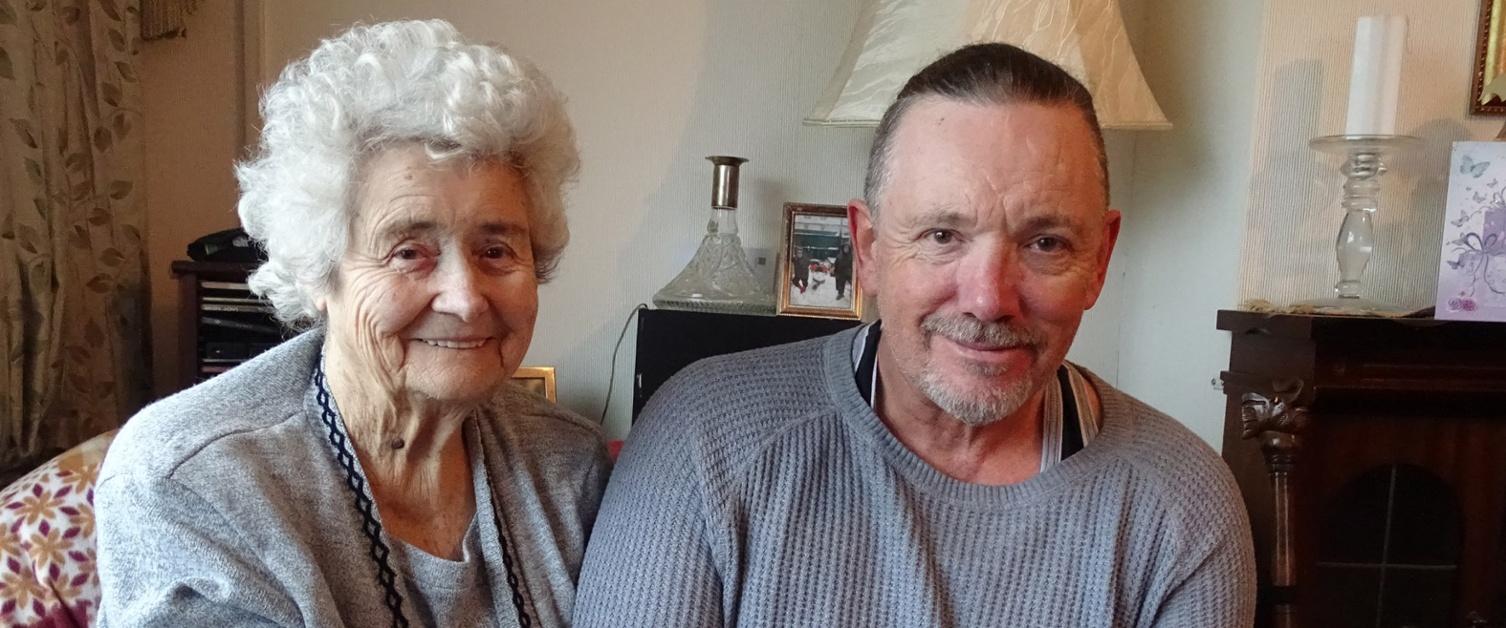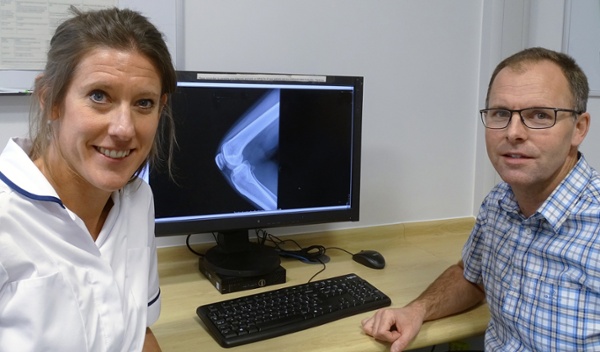New approach to treating wrist fractures breaks with tradition

A specialist team at Morriston Hospital has made a clean break with tradition when it comes to treating fractured wrists.
The first Covid lockdown forced a rethink in how simple fractures that did not require surgery were managed.
Clinicians at Morriston agreed the best approach would be for patients to self-manage at home, with instructions on how to remove the plaster cast and what physiotherapy exercises they should do.
Main photo above: Eira Griffiths, pictured with son Hugh Deeley, has experienced the new approach
It proved so successful it has now become the standard approach, freeing up fracture clinic appointments for those who really need them and saving patients unnecessary journeys to hospital.
A minimally displaced distal radius (wrist) fracture is where the bone cracks part or all the way through but maintains its proper alignment.
This is opposed to a displaced fracture, where the bone snaps in two or more pieces and the ends do not line up.
Treatment for minimally displaced fractures – sometimes called simple stable fractures – usually involves a plaster cast, which is worn for four to six weeks before being removed.
Previously, this would have involved at least two hospital trips. But the restrictions imposed during Covid forced a rethink.
Consultant orthopaedic surgeon Andrew Bebbington explained: “During the first lockdown, people were still getting some injuries and we had to decide how they could be treated.
“Those with displaced fractures need to be brought back for surgery or manipulation. But there are a group of patients who only need a plaster cast for five weeks.
“Usually we would see them in the fracture clinic a few days later, then again in five weeks when they had the plaster removed.
“Instead we said, ‘You don’t need to be seen by us. Use the plaster you were put in when you first went to A&E and take it off at home after five weeks’. We don’t see them again. That alone saved two appointments.
“After the first lockdown had settled, probably around a year later, we looked at some of these patients to see how they were doing.
“And there were so few problems we thought we could roll it out as a way of going forward.”
Patients were followed up by telephone after six months as part of a study into the outcomes. Satisfaction levels were high, though a small number had issues with the instructions they had been given.
 Consultant physiotherapist Anne-Marie Hutchison said: “We took that on board. We improved the information booklet and have made a video.
Consultant physiotherapist Anne-Marie Hutchison said: “We took that on board. We improved the information booklet and have made a video.
Right: Dr Anne-Marie Hutchison and Mr Andrew Bebbington
“This features Mr Bebbington explaining it is a stable, simple fracture which does not require them to come back to hospital, but can be safely managed at home. They do not need another X-ray or a splint.”
The video also features Dr Hutchison demonstrating the physiotherapy exercises patients should carry out while they are in the cast and after it has been removed.
“The wrist is often stiff and painful immediately following removal of the cast, which can be alarming for patients,” she said.
“In the video and booklet, we assure them this pain is normal and emphasise the importance of immediately starting the exercises to resolve it.”
Someone who experienced the new approach is 87-year-old Eira Griffiths, who fractured her wrist in a fall outside her Gorsenion home just before the start of the pandemic in 2020.
The former Gorseinon Health Centre caretaker, who has since made a full recovery, spent six weeks in a cast before it was removed at home by her son Hugh Deeley.
Hugh said: “I was a first aider in the mines so it wasn’t a problem for me.
“It might not be suitable for everyone so as long as there is provision for them, I think it’s great. There are some massive benefits. Anything that helps keep people out of hospital is really positive.”
In fact, all patients have the option of contacting the fracture clinic to arrange a follow-up appointment with a doctor or physiotherapist if they have any issues.
Some do, as the new approach does not suit everyone. But the study confirmed that most do not need any follow-up support.
The Morriston team has since published its findings into this self-care approach in a specialist clinical journal, Bone and Joint Open.
However, the work is far from over. Dr Hutchison said they were now looking at whether other simple and stable fractures, including some affecting the shoulders or ankles, could be managed in a similar way.
“The year before Covid there were nearly 30,000 fracture clinic follow-up appointments. This wasn’t a sustainable way of us working,” she said.
A £2 million fracture clinic opened at Morriston last autumn, replacing the old clinic which itself had been temporarily relocated to Neath Port Talbot Hospital during the pandemic to create space for an intensive care unit.
It has a larger capacity, with more consultation, treatment and plaster rooms, as well as a plaster facility.
But it is also taking a new approach to treating fractures based around the concept of virtual clinics – again as a consequence of the pandemic.
Mr Bebbington said that, pre-Covid, all fracture patients not requiring emergency surgery came to the clinic for a face-to-face consultation the day after being seen in ED.
“We might not have needed to see these patients for another week but they were still brought to the next day’s fracture clinic,” he said.
 “They might have been in A&E for hours, until late at night, then have to come to the clinic the next morning – only to be told we would need to see them in a week for another X-ray or change of plaster.
“They might have been in A&E for hours, until late at night, then have to come to the clinic the next morning – only to be told we would need to see them in a week for another X-ray or change of plaster.
“The pandemic changed all that. We looked at the X-ray and decided what to do beforehand. We have kept that going now.
“So if you have an injury today, tomorrow morning your X-ray will be reviewed by one of us in the fracture clinic and we decide how it should be treated, without the patient present.
“After that we send the patient a letter telling them what happens next. That saves one unnecessary trip for the patient, which in turn frees up appointments in the fracture clinic.
“Before Covid there would have been on average probably 115 fracture clinic appointments per day. That is down to around 50 or 60.
“So it’s almost halved the number of face-to-face appointments, people having to travel here, especially given the car parking issues.
“It’s just a way of streamlining it. It was initially forced on us because of Covid and we’ve kept it going. And we’re probably the most forward-thinking of the virtual fracture clinics so far in Wales.
“Some places had to do it but have backtracked a little bit. We’ve kept it going, with very few complaints – in fact, the number of complaints is probably less than beforehand.”
Dr Hutchison added: “It has obviously been a massive change in culture for the public.
“Our study demonstrated that, because of the pandemic, ongoing capacity constraints, staff shortages and long waiting times, patients do accept changes in services – especially when this does not compromise the outcome of their injury.”
Rydym yn croesawu gohebiaeth a galwadau ffôn yn y Gymraeg neu'r Saesneg. Atebir gohebiaeth Gymraeg yn y Gymraeg, ac ni fydd hyn yn arwain at oedi. Mae’r dudalen hon ar gael yn Gymraeg drwy bwyso’r botwm ar y dde ar frig y dudalen.
We welcome correspondence and telephone calls in Welsh or English. Welsh language correspondence will be replied to in Welsh, and this will not lead to a delay. This page is available in Welsh by clicking ‘Cymraeg’ at the top right of this page.